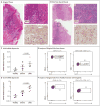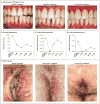Interleukin-12 and Interleukin-23 Blockade in Leukocyte Adhesion Deficiency Type 1
- PMID: 28328326
- PMCID: PMC5494261
- DOI: 10.1056/NEJMoa1612197
Interleukin-12 and Interleukin-23 Blockade in Leukocyte Adhesion Deficiency Type 1
Abstract
A patient with leukocyte adhesion deficiency type 1 (LAD1) had severe periodontitis and an intractable, deep, nonhealing sacral wound. We had previously found a dominant interleukin-23-interleukin-17 signature at inflamed sites in humans with LAD1 and in mouse models of the disorder. Blockade of this pathway in mouse models has resulted in resolution of the immunopathologic condition. We treated our patient with ustekinumab, an antibody that binds the p40 subunit of interleukin-23 and interleukin-12 and thereby blocks the activity of these cytokines, inhibiting interleukin-23-dependent production of interleukin-17. After 1 year of therapy, our patient had resolution of his inflammatory lesions without serious infections or adverse reactions. Inhibition of interleukin-23 and interleukin-17 may have a role in the management of LAD1. (Funded by the National Institute of Allergy and Infectious Diseases and others.).
Figures


Comment in
-
Breaking a Vicious Cycle.N Engl J Med. 2017 Mar 23;376(12):1172-1174. doi: 10.1056/NEJMe1615654. N Engl J Med. 2017. PMID: 28328336 No abstract available.
References
-
- Hanna S, Etzioni A. Leukocyte adhesion deficiencies. Ann N Y Acad Sci. 2012;1250:50–5. - PubMed
-
- Forlow SB, Schurr JR, Kolls JK, Bagby GJ, Schwarzenberger PO, Ley K. Increased granulopoiesis through interleukin-17 and granulocyte colony-stimulating factor in leukocyte adhesion molecule-deficient mice. Blood. 2001;98:3309–14. - PubMed
Publication types
MeSH terms
Substances
Supplementary concepts
Grants and funding
LinkOut - more resources
Full Text Sources
Other Literature Sources
